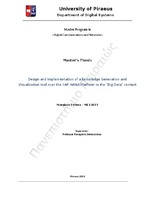| dc.contributor.advisor | Δεμέστιχας, Παναγιώτης | |
| dc.contributor.author | Μωράκος, Πέτρος | |
| dc.date.accessioned | 2015-09-21T14:38:00Z | |
| dc.date.available | 2015-09-21T14:38:00Z | |
| dc.date.issued | 2014 | |
| dc.identifier.uri | https://dione.lib.unipi.gr/xmlui/handle/unipi/7714 | |
| dc.format.extent | 105 | el |
| dc.language.iso | en | el |
| dc.publisher | Πανεπιστήμιο Πειραιώς | el |
| dc.rights | Attribution-NonCommercial-NoDerivatives 4.0 Διεθνές | * |
| dc.rights.uri | http://creativecommons.org/licenses/by-nc-nd/4.0/ | * |
| dc.subject | Client/server computing | el |
| dc.subject | Integrated software | el |
| dc.subject | Database design | el |
| dc.subject | Βάσεις δεδομένων -- Σχεδιασμός | el |
| dc.title | Design and Implementation of a Knowledge Generation and Visualization tool over the SAP HANA Platform in the "Big Data" context | el |
| dc.type | Master Thesis | el |
| dc.contributor.department | Σχολή Τεχνολογιών Πληροφορικής και Επικοινωνιών. Τμήμα Ψηφιακών Συστημάτων | el |
| dc.identifier.call | 650.028'5 ΜΩΡ | el |
| dc.description.abstractEN | Many aspects and research initiatives have shown the importance of information that are produced by the applications and the user devices. Nowadays, we receive information by different sources such as the social networking, the Rich Site Summary (RSS) feeds etc. As it is understood, these various sources of information provide disparate data. Furthermore, the user devices imposes further increases in the volume, the velocity and the variety of the data. This fact results to a difficult data management. This phenomenon in digital systems is called as the "Big Data" phenomenon. The "Big Data" phenomenon is about the heavy analysis of the data. This analysis is required in order to retrieve the meaningful insights from the large volumes of data. New architectures has been proposed for (i) handling the volume of data, (ii) aggregating, (iii) exploiting and (iv) building knowledge on them. In the Telecommunication Networks field, the "knowledge" refers to the meaningful information that the network operators needs to retrieve from his network infrastructure and it cannot be monitored. The European Committee for Standardization says that "the knowledge is the combination of data/information with the opinions/skills/experience of experts, which can be humans or computational systems and results in a valuable asset that can be used to aid decision making". A huge issue for the network operators is that the resource management of their infrastructure is fulfilled through a manual procedure which means that they collect and manage the information of their network in a manual way. This is a big obstacle for their decision making process and an opposite direction from the tendency of the automated resource management and automated decision making that all the research initiatives impose. These automated procedures for dynamic configuration and reconfiguration of the network infrastructure will result to a decrease in Operational Expenditure (OPEX) and Capital Expenditure (CAPEX) of the network enterprises. In general, the dynamic resource planning of the network is the next step for the network infrastructures as we are in a continuously changing environment with different needs and requirements for the users. So, it is worth to induce prediction loads in the network infrastructures in terms of the near or distant future in order to perform dynamic network planning and proceed to a more sophisticated decision making. This work proposes a machine learning based tool that exploits the SAP HANA Platform powered by the SAP A.G. which is a software platform that "brings to the light" the fundamentals (i.e. in-memory computing etc.) of the "Big Data" phenomenon. | en |
| dc.contributor.master | Ψηφιακά Συστήματα και Υπηρεσίες | el |



